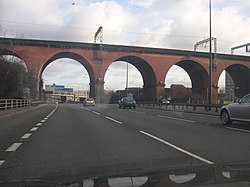Heaton Norris
| Heaton Norris | |
| Lancashire | |
|---|---|
| Location | |
| Grid reference: | SJ885909 |
| Location: | 53°25’1"N, 2°9’58"W |
| Data | |
| Post town: | Stockport |
| Postcode: | SK4 |
| Dialling code: | 0161 |
| Local Government | |
| Council: | Stockport |
| Parliamentary constituency: |
Denton and Reddish |
Heaton Norris is a suburban village in southernmost Lancashire, on the north bank of the River Mersey: the Mersey marks the border with Cheshire, across which stands Stockport.
The village is part of the Four Heatons: a series of contiguous towns of the Manchester conurbation running down to the River Mersey and the county border.
History
Heaton Norris was anciently part of the Manchester barony of the Grelley family, but between 1162 and 1180 it belonged to William le Norreys.[1]
In the early 13th century, Heaton Norris, a sub manor of Manchester, encompassed all of the Four Heatons. It was escheated to the manor of Manchester around 1280. In 1322, there were 32 dwellings suggesting a population of 150, the ten freeholders of the escheated manor had the right to graze on common pasture and to cut wood.[2] There was no chapel of ease, unlike neighbouring St Ostwalds at Didsbury, and didn't get one until St Thomas' was built in 1758.

Weaving was first recorded in 1580 and by 1776 farms were being advertised as having cowsheds and large loom houses.[1] In spite of the industrial developments nearby in Stockport and Manchester, most of Heaton Norris remained agricultural, though in 1836 there were 20 mills employing upwards of 5,000.[3] The rural nature changed with the arrival of the railway station at Heaton Norris in 1840 and Heaton Chapel in 1852, when the area became largely residential. The majority of Heaton Norris is characterised by deck-access or high-rise estates (such as Lancashire Hill) and Victorian terraced housing.

Heaton Norris Rovers, now known as Stockport County Football Club, was formed in 1883, and used to play on a pitch behind the Nursery Inn on Green Lane. In 1902, they left the Green Lane ground and moved to Edgeley Park.[4]
Geography
The former Manchester to Buxton Roman road and the later turnpike, now the A6, pass through Heaton Norris, as does the London to Manchester railway. This is carried from Edgeley to Heaton Norris by the massive brick-built Stockport Viaduct.
Along the north bank of the River Mersey ran the Great Central Railway's line from Warrington to Stockport (1852). Today this route is used by the M60 motorway; Junction 1 (formerly Junction 12 of the M63) serves Heaton Norris.
The Stockport branch of the Ashton Canal terminated at Heaton Norris.


Industry
In 1820, William Nelstrop established his flour mill on Lancashire Hill. Nelstrop's Albion Flour Mills were rebuilt on the same site in 1893 following a fire. The company is now one of Britain's largest independent flour millers.[5]
Community facilities
Notable landmarks in Heaton Norris include Bryant's Warehouse, a large B&Q superstore which was, when first opened, the largest in the country and Bowerfold Open Space, known locally as The Bonks, popular with locals for dog walking, horse riding, its football pitch, and, after heavy snowfalls, sledging. All Saints' Church, designed by Preston and Vaughan and consecrated in 1888, is on the corner of Manchester Road and All Saints Road.
Heaton Norris in the media
The village has occasionally appeared on television, as a scene or in satire:
- The Mrs Merton Show (BBC spoof chatshow) and the spin-off sitcom, Mrs Merton and Malcolm, the title character often refers to living in Heaton Norris
- Early Doors is set in a failing pub in Heaton Norris.
- Sunshine (BBC comedy drama) had scenes filmed in the Nursery Inn.
See also
Outside links
| ("Wikimedia Commons" has material about Heaton Norris) |
References
- ↑ 1.0 1.1 Heaton Moor Conservation Area Appraisal
- ↑ 'Mediæval and early modern Manchester', G.H.Tupling in Manchester and its region, pub The British Association and Manchester University Press 1962
- ↑ Heaton Norris in 1841 from Butterworth
- ↑ Green Lane Conservation Area Appraisal
- ↑ http://www.nelstrop.co.uk/company-history